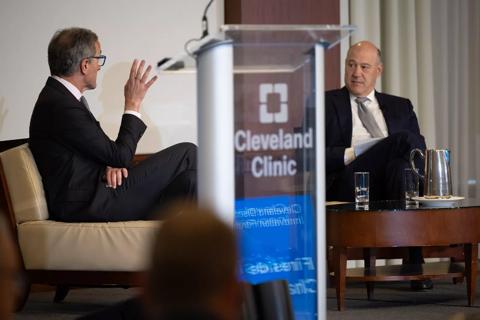20 specialties collaborated to perform 31-hour surgical procedure

Advertisement
Cleveland Clinic is a non-profit academic medical center. Advertising on our site helps support our mission. We do not endorse non-Cleveland Clinic products or services. Policy
All transplants — whether heart, lung, kidney or cornea — are significant, life-changing procedures.
A face transplant, however, is unlike any other, integrating multiple functional components (nose, lips, nasal cavity, eyelids, palate and teeth) and various types of tissue (skin, muscles, bony structures, arteries, veins and nerves).
Very few places in the world have the assembled talent and expertise to successfully complete such a complex undertaking.
Last year, a team of 11 Cleveland Clinic surgeons performed the hospital’s third face transplant – and its first total face transplant – on a 21-year-old woman who suffered severe facial trauma from a gunshot wound as a teenager.
At some point before, during or after the 31-hour surgical procedure, more than a dozen specialties were involved: plastic surgery, neurology, endocrinology, nursing, transplant surgery, anesthesia, bioethics, dentistry, ophthalmology, infectious disease, pharmacy, psychiatry, nutrition, plastics research, internal medicine, physical medicine and rehabilitation (physical, occupational and speech therapies), vascular medicine, and vascular surgery.
Only an institution that truly functions as a team can pull together that many people for a shared sense of purpose. It requires not only expertise, planning and leadership, but also the humility to focus on the patient’s outcome rather than who gets the credit. On a team comprised of about 20 specialties, it’s clear we are better together than we are individually.
Advertisement
Taken in its totality, the face transplant illustrates what Cleveland Clinic is all about. Exceptional clinical and surgical care, combined with research and innovation, has the power to improve patient lives in dramatic ways.
Today, our most recent face transplant patient — 22-year-old Katie Stubblefield — is featured on the cover of National Geographic. The story tells of her resilience, from the self-inflicted gunshot wound to the 31-hour surgery to how her life has changed after her face transplant.
She is thinking about college (with plans of becoming a counselor or a teacher). She has talked about simply walking down the street “and blending in.” As part of the pre-surgical screening process, Katie often was asked whether she was certain about going through with the surgery. She did not hesitate. “I can’t go backward. I have to go forward,” she told our ethics committee. She later reiterated that sentiment to a member of her care team: “I want to be able to go out in the world. And not be looked at like this.”
Form and function are intertwined. We cannot view this in only a strictly medical sense. Yes, function — breathing, eating, talking, seeing — is crucial. But so is form. Our face is what defines us. It’s how we socially and emotionally communicate with each other as human beings. And now — to paraphrase Dr. Maria Siemionow, who led Cleveland Clinic’s first face transplant in 2008 — Katie has a face to face the world.
Advertisement
Advertisement

Advanced software streamlines charting, supports deeper patient connections

How holding simulations in clinical settings can improve workflow and identify latent operational threats

Interactive Zen Quest experience helps promote relaxing behaviors

Cleveland Clinic and IBM leaders share insights, concerns, optimism about impacts

Cleveland Clinic partners with Palantir to create logistical command center

A Q&A with organizational development researcher Gina Thoebes

Cleveland Clinic transformation leader led development of benchmarking tool with NAHQ

Raed Dweik, MD, on change management and the importance of communication